The browser market has been mostly static for a few months. Let’s check the latest figures from StatCounter?…
Worldwide Desktop & Tablet Browser Statistics, March to April 2015
The following table shows browser usage movements during the past month.
| Browser | March | April | change | relative |
|---|---|---|---|---|
| IE (all) | 17.88% | 18.25% | +0.37% | +2.10% |
| IE11 | 10.63% | 10.76% | +0.13% | +1.20% |
| IE10 | 1.74% | 1.81% | +0.07% | +4.00% |
| IE9 | 2.18% | 2.26% | +0.08% | +3.70% |
| IE6/7/8 | 3.33% | 3.42% | +0.09% | +2.70% |
| Chrome | 49.07% | 49.97% | +0.90% | +1.80% |
| Firefox | 16.81% | 16.77% | -0.04% | -0.20% |
| Safari | 5.51% | 4.77% | -0.74% | -13.40% |
| iPad Safari | 5.42% | 5.09% | -0.33% | -6.10% |
| Opera | 1.62% | 1.61% | -0.01% | -0.60% |
| Others | 3.69% | 3.54% | -0.15% | -4.10% |
Worldwide Desktop & Tablet Browser Statistics, April 2014 to April 2015
The following table shows browser usage movements during the past twelve months:
| Browser | April 2014 | April 2015 | change | relative |
|---|---|---|---|---|
| IE (all) | 21.41% | 18.25% | -3.16% | -14.80% |
| IE11 | 8.33% | 10.76% | +2.43% | +29.20% |
| IE10 | 3.60% | 1.81% | -1.79% | -49.70% |
| IE9 | 3.31% | 2.26% | -1.05% | -31.70% |
| IE6/7/8 | 6.17% | 3.42% | -2.75% | -44.60% |
| Chrome | 45.33% | 49.97% | +4.64% | +10.20% |
| Firefox | 18.60% | 16.77% | -1.83% | -9.80% |
| Safari | 9.77% | 9.86% | +0.09% | +0.90% |
| Opera | 1.37% | 1.61% | +0.24% | +17.50% |
| Others | 3.52% | 3.54% | +0.02% | +0.60% |
(The tables show market share estimates for desktop browsers. The ‘change’ column is the absolute increase or decrease in market share. The ‘relative’ column indicates the proportional change, i.e. 8.8% of IE9 users switched browsers last month. There are several caveats so I recommend you read How Browser Market Share is Calculated and StatCounter vs NetMarketShare.)
It’s the usual story. Chrome had the biggest jump and now stands a fraction under 50% of the market. Firefox and Opera dropped a little, but the biggest loser was Safari. Both the Mac OS and iPad versions decreased but Apple is unlikely to be concerned given their recent $13.6 billion quarterly profits!
The only other browser to make a gain was IE. Talking of which…
Goodbye Internet Explorer, Hello Edge
We’ve known about Microsoft’s new browser for some time. It has now received an official name: Microsoft Edge.
Meh. I liked “Spartan”.
Does the new logo look familiar?…

It’s a sensible choice. Existing IE users who don’t know or care about Edge won’t notice any difference — they’ll still click that blue ‘e’ icon.
The name and logo are a little underwhelming. Perhaps Microsoft could have been more radical? That said, users rarely like major changes (Windows 8 anyone?) Here’s a look at a recent build of the browser to whet your appetite.
Worldwide Mobile Browser Statistics, March to April 2015
Mobile usage grew marginally to reach 33.47% of all web activity.
The top mobile browsing applications:
| Mobile Browser | March | April | change | relative |
|---|---|---|---|---|
| Chrome | 31.50% | 32.30% | +0.80% | +2.50% |
| iPhone | 20.65% | 19.49% | -1.16% | -5.60% |
| Android | 18.48% | 17.96% | -0.52% | -2.80% |
| UC Browser | 12.71% | 13.69% | +0.98% | +7.70% |
| Opera Mini/Mobile | 8.41% | 9.09% | +0.68% | +8.10% |
| IEMobile | 2.13% | 2.20% | +0.07% | +3.30% |
| Nokia Browser | 2.40% | 2.12% | -0.28% | -11.70% |
| Others | 3.72% | 3.15% | -0.57% | -15.30% |
The mobile market remains lively and most users stick with the default browser on the device. For iPhone users, that’s Safari — Apple don’t permit other rendering engines. It dropped below 20% for the first time since December 2013. However, the iPhone remains exceptionally popular so it’s unlikely to be a long-term trend.
At the lower end of the chart, IEMobile has overtaken the ancient Nokia browser to become the sixth most-popular application. But 2.2% of the market is barely cause for a celebration. Perhaps Microsoft Edge will fare better?
Craig is a freelance UK web consultant who built his first page for IE2.0 in 1995. Since that time he's been advocating standards, accessibility, and best-practice HTML5 techniques. He's created enterprise specifications, websites and online applications for companies and organisations including the UK Parliament, the European Parliament, the Department of Energy & Climate Change, Microsoft, and more. He's written more than 1,000 articles for SitePoint and you can find him @craigbuckler.
